WNET / UCH Urban Academy
“Exploring Powerful Ideas Inquiry-Based Teaching: Discussing a Teacher’s Role”
SUPPORTING QUIETER STUDENTS
TERRY WEBER:
We’ve talked about a lot of elements that sort of make up the class structure in terms of – but what do you do with kids who haven’t spoke in class for three periods, four periods, five periods? Um, which we’ve all sort of run up against and how do you do with kids whose hand goes up every two seconds?
AVRAM BARLOWE:
I think that underscores a very important point which is not every kid participates by speaking. There are some kids who really will listen and, and, and won’t necessarily speak. It doesn’t meant they’re not participating. Now, if they’re doing the writing assignments, you’re gonna hear a lot about that. Um, and you’re gonna get their voice and get their perspective and sometimes you can take what they’ve written and bring it to the class.
ADAM GRUMBACH:
I’m wondering if there’s a clip- I mean you have a classroom of (shoots hand up).
(laughter)
SHEILA KOSOFF:
But then there’s Ebony.
(in classroom)
Ebony?
EBONY:
Um, can I go back a little bit?
SHEILA KOSOFF:
Yes. Of course.
EBONY:
He was talking about how he said…he called her a “disgustingly conventional little girl”. I think in part one that he wanted Lolita. He knew that she was disgusting and he felt the same way about her in the beginning but he wanted her because I felt like he was still a little boy. And once part two came and after he had her and everything like that, the like- he started to realize, okay, I am not a little boy. I’m a grown man and this is a little girl and I’ve run away with…
(in roundtable)
SHEILA KOSOFF:
Ebony at the beginning of the course did not want to be in the class. She felt like she was out of her league and she didn’t – she never said anything. She kept her hands down and never really participated and so it was interesting that day she felt like it all came together for her and she was able to raise her hand and able to, you know, comment and share her thoughts.
So I was thinking about what you were saying, “What do you do with those kinds of kids?” and with Ebony I would meet with her after class and she would say, “I really wanted to say this. Would that have been okay?” And I’m like “You can say this in class.” Like she- it took her awhile - she’s a new student – to accept that not everyone had the answers and she could eventually come to the class and, you know, say something and it would be okay. That there was no judgement.
(in class)
EBONY:
I agree with Gigi. I think he is scared of hisself and I don’t think- I think in the beginning it was just a dream. He didn’t really think that he would be able to get Lolita and once he got her he kind of woke up like, “Oh, okay, now I have to figure out how to cover myself because I can get in trouble for this.”
SHEILA KOSOFF:
Okay.
(in roundtable)
AVRAM BARLOWE:
If they’ve never been asked to speak in that voice when they write or speak that way in the classroom, then that, it’s precisely that kind of coaching that Sheila’s giving them outside the classroom that – where you approach the kid and say, “Well, what do you think?” Or, or, you know, it looked like you were gonna say something or it looked like you felt- What did you think about- and begin to develop dialogue with the kids outside the class, um, you know. That’s one vehicle for opening things up. Sometimes students like that. Also they might be more comfortable discussing the issue in a smaller group than you create in the classroom where they don’t feel the gaze of everybody upon them and they can say certain things.
TERRY WEBER:
So you’ll have small groups in the beginning of the class and bring the whole class together later.
AVRAM BARLOWE:
You can do that. I mean there’s lots of ways at getting at those voices.
*** TAPE END ***
*** TRANSCRIPT END ***

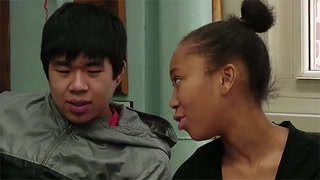

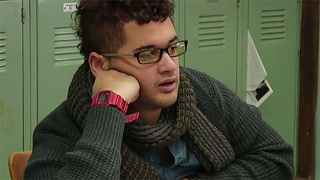

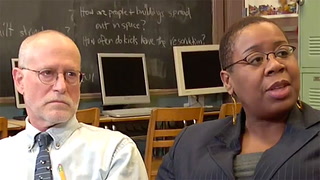

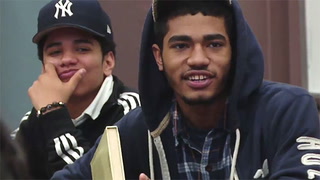
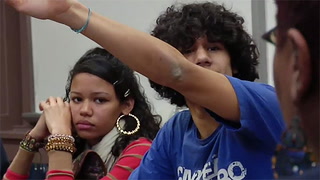

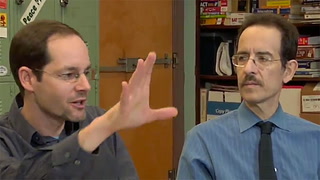










14 Comments
Beto RIncon Jan 8, 2023 6:32pm
Robin Stricklin Dec 10, 2019 8:29pm
I do encourage the quiet students in my class to speak. I let them know they are smart and have good ideas to share. I want to hear from them. It's important for these students to find the confidence in themselves.
Erin Intrabartola May 1, 2018 8:08am
k t Nov 4, 2017 6:51pm
Talia Venancio Nov 19, 2016 6:31pm